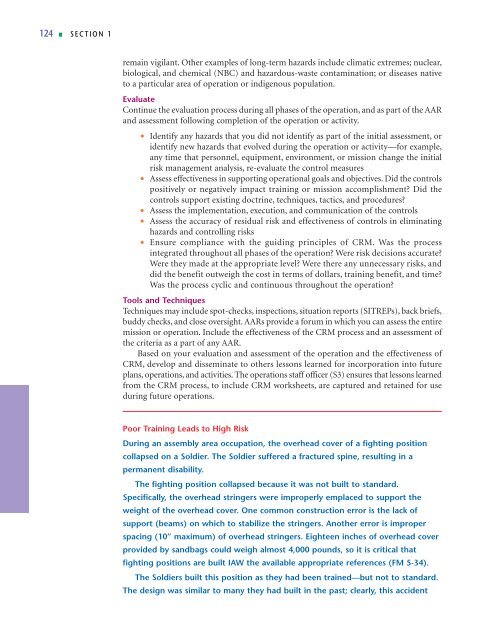Composite Risk Management.pdf - UNC Charlotte Army ROTC
Composite Risk Management.pdf - UNC Charlotte Army ROTC
Composite Risk Management.pdf - UNC Charlotte Army ROTC
- No tags were found...
Create successful ePaper yourself
Turn your PDF publications into a flip-book with our unique Google optimized e-Paper software.
124 ■ SECTION 1remain vigilant. Other examples of long-term hazards include climatic extremes; nuclear,biological, and chemical (NBC) and hazardous-waste contamination; or diseases nativeto a particular area of operation or indigenous population.EvaluateContinue the evaluation process during all phases of the operation, and as part of the AARand assessment following completion of the operation or activity.• Identify any hazards that you did not identify as part of the initial assessment, oridentify new hazards that evolved during the operation or activity—for example,any time that personnel, equipment, environment, or mission change the initialrisk management analysis, re-evaluate the control measures• Assess effectiveness in supporting operational goals and objectives. Did the controlspositively or negatively impact training or mission accomplishment? Did thecontrols support existing doctrine, techniques, tactics, and procedures?• Assess the implementation, execution, and communication of the controls• Assess the accuracy of residual risk and effectiveness of controls in eliminatinghazards and controlling risks• Ensure compliance with the guiding principles of CRM. Was the processintegrated throughout all phases of the operation? Were risk decisions accurate?Were they made at the appropriate level? Were there any unnecessary risks, anddid the benefit outweigh the cost in terms of dollars, training benefit, and time?Was the process cyclic and continuous throughout the operation?Tools and TechniquesTechniques may include spot-checks, inspections, situation reports (SITREPs), back briefs,buddy checks, and close oversight. AARs provide a forum in which you can assess the entiremission or operation. Include the effectiveness of the CRM process and an assessment ofthe criteria as a part of any AAR.Based on your evaluation and assessment of the operation and the effectiveness ofCRM, develop and disseminate to others lessons learned for incorporation into futureplans, operations, and activities. The operations staff officer (S3) ensures that lessons learnedfrom the CRM process, to include CRM worksheets, are captured and retained for useduring future operations.Poor Training Leads to High <strong>Risk</strong>During an assembly area occupation, the overhead cover of a fighting positioncollapsed on a Soldier. The Soldier suffered a fractured spine, resulting in apermanent disability.The fighting position collapsed because it was not built to standard.Specifically, the overhead stringers were improperly emplaced to support theweight of the overhead cover. One common construction error is the lack ofsupport (beams) on which to stabilize the stringers. Another error is improperspacing (10” maximum) of overhead stringers. Eighteen inches of overhead coverprovided by sandbags could weigh almost 4,000 pounds, so it is critical thatfighting positions are built IAW the available appropriate references (FM 5-34).The Soldiers built this position as they had been trained—but not to standard.The design was similar to many they had built in the past; clearly, this accident
















